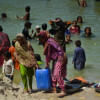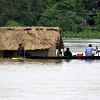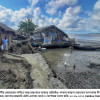Why the lack of data on how climate change affects public health?

After decades of unwavering collaboration among government bodies, non-governmental organisations, and development partners, Bangladesh stands out among low- and middle-income countries (LMICs) for its improved health outcomes, especially in maternal and child health. Bangladesh's current maternal mortality rate is 123 per 100,000 live births, significantly lower than the LMICs' average of 232. Our under-five mortality rate is also commendable at 31 per 1,000 live births. These successes are thanks to the expansion of maternal healthcare, increased use of modern contraception, and lower fertility rates. But despite these strides, Bangladesh falls short of Sustainable Development Goal targets set for 2030, just six years away. Slower progress in maternal and child health indicators, coupled with stagnation in contraception use, present challenges. To address them, Bangladesh must prioritise all potential impediments to maternal and child health.
Of these, climate change and its adverse effects on maternal and child health have gained significant attention recently. The discussions have been intensified by the increasing frequency and severity of heatwaves, droughts, floods, and cyclones, with projections that these challenges will escalate in the years ahead. However, it is crucial to note that these discussions often lack a solid foundation in extensive data for Bangladesh. Available data mainly relies on small-scale surveys or localised evidence, insufficient for shaping national-level policies and programmes to address these developing issues. Adding to the complexity is the fact that different parts of the country experience varying weathers and climate events. For example, while Sylhet and Sunamganj faced serious floods in 2023, Rangpur Division experienced a severe drought. Consequently, bridging these data gaps is increasingly urgent. Failing to do so may hinder the development of effective policies, potentially slowing down progress in improving maternal and child health in the country.
The primary challenge in bridging these data gaps is the scarcity of longitudinal surveys, with only a few sources available. One notable example is the Chakaria Health and Demographic Surveillance System established by the International Centre for Diarrheal Disease Research, Bangladesh (icddr,b) on the south-eastern coast of the Bay of Bengal. However, these sources often represent specific regional experiences rather than providing a comprehensive national perspective.
Meanwhile, government data concerning weather and climate events are highly fragmented, reported by various independent organisations. For instance, the Bangladesh Meteorological Department records a wide range of data related to weather, climate, and hydrology through its countrywide network. Similarly, the Department of Public Health Engineering reports data on water salinity. However, the challenge lies in consolidating these disparate sources to create a comprehensive picture, especially when obtaining long-term observations is crucial to categorise these events as climate-related rather than just weather-related. Furthermore, the government records data on healthcare services access and diseases through DHIS 2, a system which has limitations, including the absence of unique patient IDs, the lack of a standardised transfer mechanism, limited coverage of government healthcare facilities, and the exclusion of private healthcare facilities. These challenges hinder establishing connections between climate-related events and health facility-level data.
For example, migrants from climate-vulnerable areas are often labelled as climate-induced migrants, without considering the broader reasons behind their migration. In reality, such migrations may be motivated by people seeking an improved quality of life (a trend boosted by advancements in transportation and communication), urban job opportunities, and declining agricultural profitability. Consequently, many of these migrations are intentional rather than directly caused by climate change. Unfortunately, existing surveys, including those conducted by individual researchers, often fail to make this distinction.
The situation is further complicated by Bangladesh's heavy reliance on surveys such as the Bangladesh Demography and Health Survey or the Multiple Indicator Cluster Survey. The nature of these surveys make them ill-equipped to present data on weather and climate events or record environmental indicators. Moreover, exploring climate change effects often necessitates long-term observations, which are not feasible to do for those in charge of carrying out these commonly utilised surveys. Additionally, surveys conducted by development partners to investigate the impacts of adverse climate and weather events are usually not publicly accessible because they primarily focus on observing the impact of climate change/natural disasters on their development interventions. Consequently, the true extent of the effects of adverse weather and climate events remains largely unknown.
Despite these challenges, there's a prevailing tendency to attribute common issues to climate-induced factors, influenced by the global focus on climate change and its adverse consequences. For example, migrants from climate-vulnerable areas are often labelled as climate-induced migrants, without considering the broader reasons behind their migration. In reality, such migrations may be motivated by people seeking an improved quality of life (a trend boosted by advancements in transportation and communication), urban job opportunities, and declining agricultural profitability. Consequently, many of these migrations are intentional rather than directly caused by climate change. Unfortunately, existing surveys, including those conducted by individual researchers, often fail to make this distinction. This failure to differentiate can lead to inaccurate estimations of subsequent effects, such as early marriage and limited access to maternal healthcare services, both closely linked to maternal and child health outcomes in Bangladesh. The key distinction is that climate-induced migration is often unintentional, significantly differing from intentional migration, and their subsequent consequences may not be comparable, despite both leading to migration.
Moreover, available surveys often struggle to distinguish between climate events and weather events, despite the common practice of categorising all such events as climate change-related. For example, Bangladesh has historically faced large-scale storms and cyclones—like those in 1991, 2007, and 2009—leading to significant migration of people from affected areas to major urban and divisional cities. These events are, in fact, adverse weather events rather than strictly climate-related, despite the prevailing tendency to label them as such. Additionally, there's often ambiguity in defining recent natural hazards, like the floods in Bandarban or in Sunamganj, regarding whether they resulted from adverse climate events or human-made hazards linked to unplanned development. Similarly, river erosion, in many cases, is worsened by human activities, including riverbank encroachment and alterations to the river's course. We must exercise caution, because mislabelling any human-made hazard as an adverse climate event may inadvertently contribute to these issues in the future rather than mitigating them, posing significant health concerns.
Climate change is undeniably a pressing concern in Bangladesh, causing adverse health impacts, particularly on maternal and child health. Thoroughly investigating these effects is crucial, and requires specialised surveys that encompass a range of weather, climate, and environmental indicators. The government should take the lead in this endeavour by collaborating with both national and international organisations which have experience in conducting relevant surveys.
Dr Md Nuruzzaman Khan is assistant professor at the Department of Population Science of Jatiya Kabi Kazi Nazrul Islam University in Mymensingh, Bangladesh.
Views expressed are the author's own.
Follow The Daily Star Opinion on Facebook for the latest opinions, commentaries and analyses by experts and professionals. To contribute your article or letter to The Daily Star Opinion, see our guidelines for submission.

 For all latest news, follow The Daily Star's Google News channel.
For all latest news, follow The Daily Star's Google News channel. 










Comments